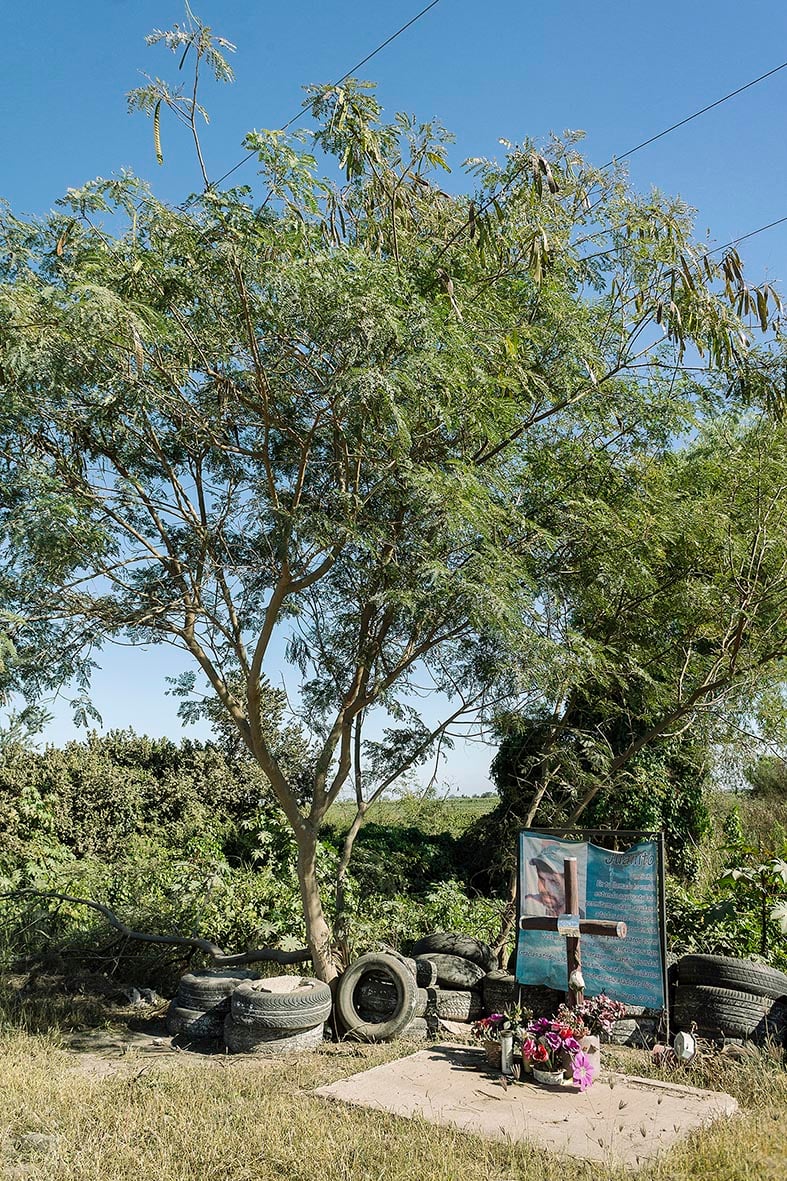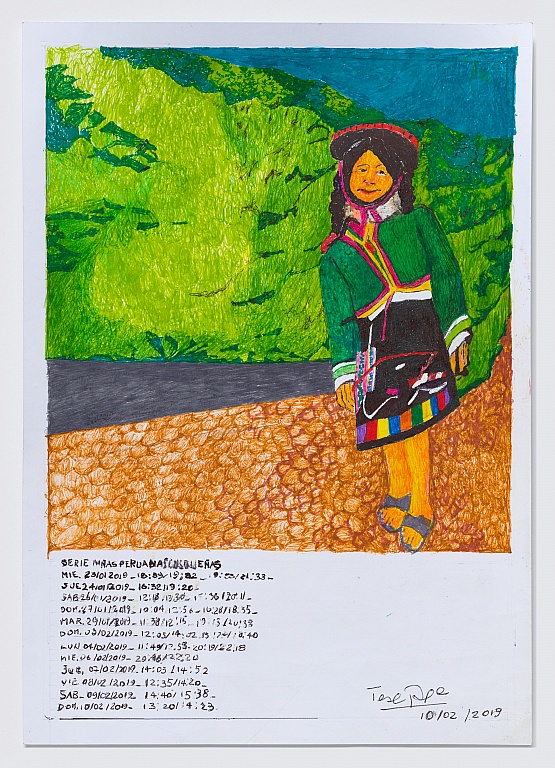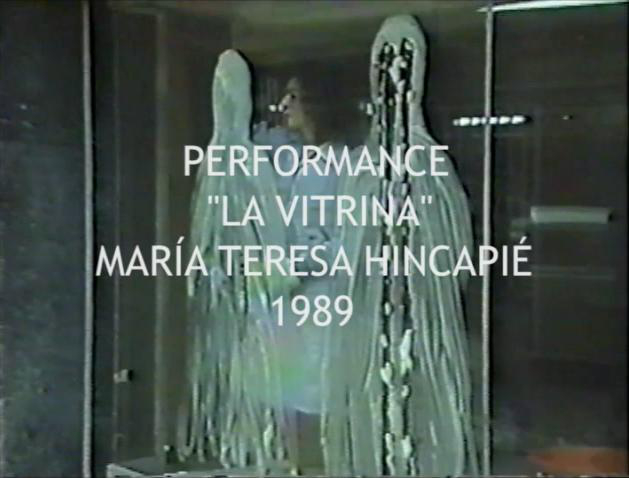
© » KADIST
Teresa Margolles
Stretching between San Pedro and the beach in Altata, Sinaloa, there is a 40 km road where there are three invisible borders controlled by rivalling armed groups. There is a price to pay for crossing these territories. This series of 21 photographs by Teresa Margolles, titled 40 Km , resemble snapshots of peaceful lands, but also bear witness to the reality lived by the local people in this area.

© » KADIST
Teresa Burga
Drawing & Print (Drawing & Print)
In her new series titled Ninas Peruanas Cusquenas , Teresa Burga depicts young indigenous women from Peru’s Andean region, dressed in traditional garments. Sourcing imagery from the internet, the drawings recall an untitled series of drawings from 1974, in which Burga selected images of women at random from various print media, and then rendered the images on paper. Those drawings, like the newer ones, suggest the perils of images without context––how assumptions are made, stereotypes are formed, and knowledge is gathered.

© » KADIST
Ana Teresa Fernández
Drawing & Print (Drawing & Print)
The artist writes about her work Borrando la Frontera, a performance done at Tijuana/San Diego border: “I visually erased the train rails that serve as a divider between the US and Mexico. I painted them sky blue, creating a “Hole in the Wall” This deconstruction of “feminized” work explores the difficulties in reconciling both low wages and undervalued work via social and political infrastructures, confronting issues of labor and power. The images that I myself perform, present a duality: women dressed in a black tango dance attire while engaging in de-skilled domestic chores; the surreal within non-fiction.

© » KADIST
Rajni Perera
Drought Mask by Rajni Perera is a prototype that is suggestive of dire implications for human survival. Directly addressing the urgent climate crisis, specifically wide-spread drought, this sculpture imagines hybrid cultural aesthetics of the near-future after global collapse. Composed of various woven textiles complete with frills and fringes, leather, a gas mask, and pencil, Rajni’s mask prefigures future dystopian characters who are resilient and resourceful; self-fashioning tools for survival.

© » KADIST
Ron Terada
Drawing & Print (Drawing & Print)
The three Maiko s were included in Ron Terada’s 2008 exhibition, Voight–Kampf , at Catriona Jeffries gallery. More ambitious in size and subject matter, this show with its complex video installation marked a new path for Terada’s work. Voight-Kampf is based on a scene from Ridley Scott’s 1982 movie Blade Runner in which a giant advertising billboard in the midst of a dystopian city of Los Angeles in the future displays a geisha eating candy.

© » KADIST
María Teresa Hincapié
In the performance video Vitrina , María Teresa Hincapié stood inside a storefront window in downtown Bogota, unannounced, for eight hours a day, wearing a uniform and initially carrying out cleaning chores. As the day and passers went by, the routine became more playful: she would send kisses to bus drivers on the busy Avenida Jiménez who would return them, use the newspaper with which she was shining the glass to flirtatiously hide and engage with an improvised audience or draw the shape of her body with soap and a sponge. She would interrupt these chores to carry out other ‘feminine’ activities, like brushing her hair or applying make-up, only to return to frantically cleaning the transparent surface that separated her from the public.

© » KADIST
Tessa Mars
In this untitled acrylic painting, Tessa Mars explores the long-lasting effects of colonialism on the Afro-Caribbean diaspora, particularly in terms of female vulnerability and resilience. Drawing on her interest in retelling stories of her native country, and confronting the past and the present, Mars portrays her cultural essence and heritage by imagining spiritual spaces that connect people and land across time. With a pictorial practice that highlights pastel colors, the divinisation of the figures on the canvas and the spiritual elements within the composition ultimately enhance the narrative of her Caribbean ancestry while conflating the distinctions between autobiographical and historical events.

© » KADIST
Alejandro Almanza Pereda
This still life falls apart, or rather floats apart as the composition is proved unstable and constantly morphing. An impossible attempt at achieving a fixed state, some objects remain buoyant and some objects sink, constantly tilting the overall scale and arrangement. Properties of weight, mass and shape have their own will but a hand appears in the scene, pushing back on these mysterious forces.
Teresa Margolles
Teresa Margolles’s work examines the social causes and consequences of violence...
Teresa Burga
A pioneer of Latin American Conceptualism, since the 1960s, Teresa Burga has made works that encompass drawing, painting, sculpture, and conceptual structures that support the display of analytical data and experimental methodologies...
Ron Terada
Ron Terada belongs to a generation of Vancouver-based artists that follows the well-known Vancouver School of photoconceptualists which includes Jeff Wall, Stan Douglas, and Ian Wallace...
Alejandro Almanza Pereda
Alejandro Almanza Pereda has a heightened understanding of the essence of objects...
Tessa Mars
Tessa Mars delves into Haitian history, her primary source of inspiration, to unveil a colourful and provocative universe that she wishes to reclaim...
Rajni Perera
Rajni Perera’s practice foregrounds a hybrid model that merges immigrant politics, feminine power, mythology, and science fiction...
-
1980-1989
María Teresa Hincapié
1989In the performance video Vitrina , María Teresa Hincapié stood inside a storefront window in downtown Bogota, unannounced, for eight hours a day, wearing a uniform and initially carrying out cleaning chores...
-
2000-2009
Ron Terada
Drawing & Print
2008(Drawing & Print) The three Maiko s were included in Ron Terada’s 2008 exhibition, Voight–Kampf , at Catriona Jeffries gallery...
-
2010-2019
Ana Teresa Fernández
Drawing & Print
2011(Drawing & Print) The artist writes about her work Borrando la Frontera, a performance done at Tijuana/San Diego border: “I visually erased the train rails that serve as a divider between the US and Mexico...
Teresa Margolles
2014Stretching between San Pedro and the beach in Altata, Sinaloa, there is a 40 km road where there are three invisible borders controlled by rivalling armed groups...
Alejandro Almanza Pereda
2015This still life falls apart, or rather floats apart as the composition is proved unstable and constantly morphing...
Teresa Burga
Drawing & Print
2019(Drawing & Print) In her new series titled Ninas Peruanas Cusquenas , Teresa Burga depicts young indigenous women from Peru’s Andean region, dressed in traditional garments...
-
2020-2029
Rajni Perera
2021Drought Mask by Rajni Perera is a prototype that is suggestive of dire implications for human survival...
Tessa Mars
2022In this untitled acrylic painting, Tessa Mars explores the long-lasting effects of colonialism on the Afro-Caribbean diaspora, particularly in terms of female vulnerability and resilience...